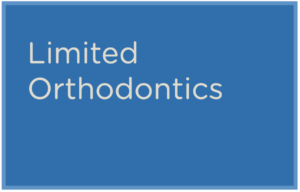Limited Orthodontics
Limited orthodontics is what we call putting braces on only some of the teeth – perhaps only on the upper or the lower arch, perhaps only on the front teeth. But it is different than comprehensive orthodontics in that its intention is limited to a specific goal.
Comprehensive orthodontics really can’t begin until almost all of the permanent teeth are in place – for some children this happens as early as 10 years of age, but more typically around 12 or 13 years. The reason comprehensive orthodontics can’t work on kids much younger than that is that the baby teeth are simply too flat to retain the bite position attained through the bracket and wire mechanics.
However, limited orthodontics on a child (age 6-9) will be strongly advised when:
- Front teeth are significantly rotated (this is so hard to correct later!)
- Front teeth are protruded (sticking out) such that they are in jeopardy of being traumatized
- The spacing of the front teeth is such that there is no good path for a permanent tooth to erupt nearby.
Limited orthodontics can be considered elective (rather than urgently recommended) when:
- Minor crowding of upper and/or lower front teeth
- Spaces are present between the front teeth, but all the teeth have enough room to erupt.
Limited orthodontics will not be effective when:
- A bad bite is caused by poor posture
- An anterior open bite is caused by tongue thrusting or faulty swallow pattern, or thumb sucking
In many instances, crowded teeth can reveal a hidden cause that requires a team effort to overcome. Tongue position for healthy rest posture and swallows is best address through a combination of interceptive orthodontics and orofacial myology. Habit correction appliances are also often combined with orofacial myology, which retrains the patient’s musculature or substitutes healthy new habits to replace the habits with bad effects. When posture is the driving cause of a bad bite, an evaluation with integrative postural therapy is indicated.
Below are few cases of successful Limited Orthodontics – both cases took less than 6 months to treat, and the patients will use orthodontic retainers for 6 months at night.




